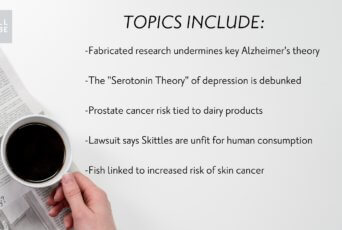Trying to stay on top of health- and wellness-related news and events can be overwhelming. And this was BIG news month. It’s a lot to digest (pun intended). We saved you the trouble. Here’s what happened in December, WellBe-style.
1. The EPA doesn’t think glyphosate is carcinogenic
What: The Environmental Protection Agency (EPA), said they don’t think glyphosate, a widely used herbicide, has any health risk to people. In 2015, the World Health Organization’s International Agency for Research on Cancer (IARC) said the chemical is “probably carcinogenic.” Confused? Same here.
The Details: Glyphosate, best known as the main ingredient in Monsanto’s Roundup weed killer, is pretty controversial. Ever since the IARC made their announcement, critics and supporters have traded conclusions over it. Naturally, Monsanto and U.S. corn, soy, and wheat farmers rejected the WHO’s finding— glyphosate is a mainstay of large-scale farming.
In their most recent assessment, the EPA said glyphosate isn’t likely to cause cancer and that it found “no other meaningful risks to human health” when the chemical is used according to label instructions.
If you remember, in July 2017, California added glyphosate to their list of cancer-causing chemicals. Monsanto and some U.S. farm groups sued the state in November to stop them from requiring warning labels on products, Reuters reported. Aggressive much?
Around the same time, the EU renewed glyphosate’s registration for use for another five years (the deliberations between countries were pretty contentious). Then President Macron of France said, “Le no. We’re getting rid of this stuff in the next three years.” (paraphrased, of course.) Go, France!
Why Does This Matter for My Health? The EPA’s report just adds fuel for Monsanto and U.S. farm groups to keep defending the product and basically being bullies. Glyphosate is the world’s most widely produced herbicide, so we’re probably all exposed to it in some way or another, whether it’s in trace amounts in our foods or in the air when our neighbor’s lawn gets treated.
The WellBe Takeaway: This ruling by the EPA shows us just how much power Monsanto has in the U.S. We’re following France’s lead and protecting ourselves in whatever way we can. While glyphosate is kinda unavoidable, one thing we can definitely control is our food choices. We’re continuing to buy organic and skipping on anything that may be made with genetically modified crops because many of them were modified to tolerate glyphosate specifically, NPR reported. And we’re telling our family, friends with lawns and gardens, and organizations (Parks! Golf courses!), to get rid of Roundup.
2. California warns about keeping cell phones next to your body
What: The California Department of Public Health (CDPH) issued a warning this month that people should limit their cellphone use, and keep the devices away from their bodies, to protect against radiation. This comes after a professor sued the state in 2016 to get a 2009 document on the dangers of cellphones published, TechCrunch reported. The Sacramento Superior Court ordered its publication. Do you guys smell an attempt to bury this research?! We do…
The Details: There’s long been talk over whether cell phones’ radio waves are physically harmful for humans, and nothing definitive has come out, but California is playing it safe with their guidelines to reduce exposure. Their tips include:
-
Use speakerphone or a headset instead of holding the phone to your head.
-
Text instead of making phone calls.
-
Keep the phone away from your body when streaming or downloading.
-
Carry your phone in your bag, not in your pocket.
Why Does This Matter for My Health? The International Agency for Research on Cancer (yup, the same group as above in the glyphosate study) said the radio waves from cellphones are “possibly carcinogenic to humans.” A 2016 animal study found a link with higher risk of cancer in male rats. At the time, the American Cancer Society pointed out the animal study showed that the higher the dose, the larger the effect, “a key sign that this association may be real.”
There isn’t any big peer-reviewed research on this, Salon reported, but studies have purported to show that radio waves can imperil regular cerebral function in adults, retard sperm production in men, and mess with DNA processes, among other things.
In unrelated research, a study found that kids who used cellphones or watched TV at bedtime were more than twice as likely to be overweight or obese, HealthDay reported. Another study of teens suggested that compulsive smartphone use changes brain chemistry in a way that mirrors changes prompted by addiction. Not quite related to this radio wave issue, but everything points to: Put. Your. Phone. Away.
The WellBe Takeaway: We’re going with CDPH’s recommendations and keeping our phones a safe distance away from us and off our bodies. One of our 2018 wellness activist goals is to prioritize community, which for us is about stepping away from our phones and, you know, actually talking to our friends in person, so this fits in nicely.
3. Birth control may increase breast cancer risk
What: A link between breast cancer and birth control pills came out years ago, but a new study found that current formulations of hormonal contraceptives— including low-dose versions —still carry a risk.
The Details: The Danish study of 1.8 million women estimated that, for every 100,000 women, hormone contraceptive use causes 68 breast cancer cases a year, The New York Times reported. That’s 13 more than in the non-user group. The study participants ranged from age 15-49 and researchers followed them for nearly 11 years.
“This is an important study because we had no idea how the modern-day pills compared to the old-fashioned pills in terms of breast cancer risk, and we didn’t know anything about IUDs,” Dr. Marisa Weiss, an oncologist who founded the website breastcancer.org and was not involved in the study, told the NYT. “Gynecologists just assumed that a lower dose of hormone meant a lower risk of cancer. But the same elevated risk is there.”
Researchers also compared the effects of different types of hormonal birth control, including pills, the patch, the ring, implants, and progestin-releasing IUDs. They found that the method didn’t affect cancer risk, which surprised them.
The increase in breast cancers is a small number (it’s similar to the extra breast cancer risk contributed by physical inactivity, NPR reported), and that’s partly to attribute to the fact that young women are at low risk to begin with. Once women stopped using hormonal contraception, their risk fell rapidly— except for the women who’d been using it for over 5 years. They still carried an elevated risk of breast cancer for at least five more years. Researchers found that the longer birth control was used, the greater a woman’s risk.
Why Does This Matter for My Health? We’d be remiss to not mention that oral contraceptives have been associated with lower risk of some cancers— the relationship is complex (give this NYT article a read if you’re interested). But this Danish study was looking at the first generation of low-dose pills and found a risk even for hormone-releasing IUD use, which has increased in popularity. So that means it’s probably the kind you and your friends have used.
The WellBe Takeaway: We’re definitely pro-birth control and our experiences make us think that going with hormone-free methods is the best way for us. If you’re looking for a vagina-friendly condom brand, check out Sustain. We talked to their founder and she had a lot to say about why conventional brands aren’t great for you. If you’re not sure what you want to do, talk to your doc about non-hormonal methods and stand up for what you want, both with your doctor and your sexual partner.
4. FDA proposes regulating homeopathic remedies
What: The FDA announced it plans to get tougher on homeopathic medicines, specifically those with reported safety issues and those that claim to treat serious diseases like cancer.
The Details: First up, a quick primer on homeopathy. It started in the 18th century and is based on two ideas: 1) a little bit of the substances that cause disease can actually be used to treat it and 2) the substance’s potency increases with greater dilution. For example, if you have watering eyes and a runny nose from a cold, the homeopathic remedy may contain a microdose of red onion. The remedies usually come as sugar pellets to dissolve under the tongue, but can also be formulated as ointments, gels, drops, creams, and tablets.
In the last decade, the homeopathic medicine market has grown “exponentially” to a nearly $3 billion industry, according to the FDA’s press release. Like dietary supplements, the FDA doesn’t regulate homeopathic products for safety or effectiveness before they’re sold. A big difference is that homeopathic meds can state they’re intended for specific medical symptoms or conditions, like pharmaceuticals, and those have to be sold by prescription.
The FDA’s current proposal will target high-risk products and those sold for infants and children. It doesn’t totally come out of nowhere. In 2016, the FDA warned against the use of homeopathic teething tablets and gels because they could cause seizures, difficulty breathing, and muscle weakness, among other risks, specifically because of the ingredient belladonna. The teething remedy made by Hyland’s, the nation’s largest homeopathic business, may have killed eight children because of high levels of belladonna, STAT reported. In 2009, Zicam, the nasal spray, was ordered to stop marketing three of their products because more than 100 users reported losing their sense of smell.
Homeopathic groups have been supportive of this proposal, including the National Center for Homeopathy and the American Association of Homeopathic Pharmacists (AAHP). In a statement, the AAHP said it “applauds the Agency’s plan to take quick action against illegal or unsafe homeopathic medicines.”
The policy should be finalized early this year.
Why Does This Matter for My Health? Since the FDA would be specifically targeting high-risk products and pulling products they deem to be health threats, most of the stuff you find on the shelf won’t actually be affected and remain available. If you’re considering using a homeopathic remedy, do your research and watch out for those with reported safety concerns or concerning ingredients, avoid injectable products, and be wary of remedies that are intended for serious stuff like cancer and heart disease.
The WellBe Takeaway: We use homeopathic remedies (Coldcalm or Arnica cream, Calendula gel are some of our favorites), and we’re glad to see attention being paid to those that are clearly harmful, and hope this means any iffy products get taken off the shelves.
5. Low thyroid may affect fertility
What: A study found that mild low thyroid levels may interfere with a woman’s ability to get pregnant.
The Details: Harvard Medical School researchers found that mild low thyroid levels— as in, the thyroid is just slightly underactive —could be to blame for some cases of unexplained infertility. While it was known that women with low thyroid levels have a hard time with fertility, this study found that even being on the low end of the normal range could be problematic, HealthDay reported.
Hypothyroidism (underactive thyroid) is diagnosed when a person has a thyroid-stimulating hormone (TSH) level of 4.5 or 5. In their research on 187 couples with unexplained infertility, nearly 27 percent of the women had a TSH level in the low-normal range of 2.5 or greater.
Their findings may help explain some cases of unexplained fertility, but, keep in mind that it was just an association and didn’t show cause and effect.
Why Does This Matter for My Health? Thyroid hormones play an important role in fetal development early in a pregnancy, so doctors know to look out for it and treat as necessary in order to avoid the risk of lower IQ and impaired development. This study suggests that patients who are trying to get pregnant be screened, too. One expert told HealthDay that doctors should look deeper at the root cause of a woman’s low thyroid, as that may be the real reason behind the infertility.
The WellBe Takeaway: WellBe founder Adrienne has a low thyroid and has used Nature-Throid, a natural thyroid replacement medication, to manage it. But she is still on the hunt to figure out the root cause and bring her thyroid up to normal levels. We’ve all had friends struggle with trying to get pregnant, and now we’re going to suggest they have their docs look into their thyroid to see if that could be a marker of the problem, and most of all, fix the root cause.
6. Nutritional deficiencies may affect mental health
What: In a review of 28 studies, researchers found specific nutritional deficiencies in people being treated for psychotic disorders for the first time. This. is. A. Huge. Development.
The Details: The Australian team systematically reviewed research on nutritional deficiencies in 2,612 individuals being treated for psychotic disorders. While previous research has shown a strong correlation between long-term schizophrenia and various nutritional deficiencies (including vitamins B, C, D, and E), this is the first look into what may be going on during the first episode of psychosis, study authors said.
Researchers found that early psychosis is associated with large deficits of critical nutrients, with particularly low levels of vitamin B9 (folate) and vitamin D. Plus, these nutritional deficits were associated with worse mental health in young people with early psychosis.
Why Does This Matter for My Health? Psychosis is characterized as disruptions to a person’s thoughts and perceptions that make it difficult for them to recognize what’s real and what isn’t, according to the National Alliance on Mental Illness (NAMI). In the U.S., approximately 100,000 young people experience it every year. It’s a symptom, not an illness.
The study looked at people when they were first showing signs of losing contact with reality, and acting quickly to find the right treatment can be life-changing, NAMI says. The lead author of the study hopes that their findings could lead to nutritional treatments being added into standard treatment of early psychosis, including promoting a healthy diet.
In an unrelated study, researchers found that people who ate leafy green veggies daily keep their minds sharp as they age, HealthDay reported. In fact, one serving a day (that’s ½ cup of cooked spinach or kale) was like their brain function was 11 years younger than their bodies. 11 years seems like a lot to us! Researchers observed that vitamin K, folate, and lutein were among the nutrients responsible.
The WellBe Takeaway: We talk about food as medicine pretty regularly (and so do our changemakers) and the Australian study will hopefully have some psychiatrists thinking differently about how they treat psychosis and mental illness. WellBe founder Adrienne lost her mother to schizoaffective disorder in 2010, and Adrienne always suspected nutrient levels and gut issues had something to do with it. We’re reminded that mental health should be looked at holistically, with the whole body in mind.
7. Teflon ban likely avoided thousands of low-weight births
What: The phaseout of the chemical used to make Teflon was tied to a drop in pregnancy-related problems, a recent study found.
The Details: The chemical, PFOA, used to be found in many consumer products, including non-stick cookware, food packaging, electronics, and carpets. Exposure to it has been linked to cancer and other health problems, including harm to the reproductive system. After an agreement between the government and industry, it was phased out starting in 2003 and eliminated by 2014, The New York Times reported.
A New York University study found that, soon after the phaseout began, CDC tests recorded the median level of PFOA in the blood of women ages 18 to 49 began to drop, the Environmental Working Group reported. Researchers estimated PFOA ban prevented 10,000 to 17,000 low-weight births annually in the U.S.
Why Does This Matter for My Health? Low birthweight (when a baby is less than 5 pounds, 8 ounces), can put babies at risk for chronic health conditions like high blood pressure, diabetes, and heart problems, according to the March of Dimes.
The WellBe Takeaway: While low birthweight isn’t that uncommon— about 1 in every 12 births —we’re glad to see that a change like this happened and had a clear effect. Can you hear us now, chemical manufacturers? Getting rid of known toxic chemicals will reduce adverse health impacts? This study is a great example of what we hope to do more of with our wellness activist goals this year. When people stand up and demand these simple changes in industry, it helps to avoid chronic disease.
8. FDA finalizes ban on OTC antiseptics
What: Antiseptic products (like soap, hand sanitizers) containing triclosan and other active ingredients can no longer be used in healthcare settings.
The Details: The FDA finalized a rule (after years of debate) that means over-the-counter antiseptic soaps, hand sanitizers, and rubs containing triclosan and 23 other active ingredients can’t be used in hospitals or other healthcare situations (think surgical hand scrubs and antiseptic preparations used on patients’ skin before surgery).
Triclosan, a pesticide, was banned from consumer soaps and body washes in 2016, after manufacturers failed to show it prevented the spread of germs better than plain soap and water. And there’s concern that it may affect hormones and contribute to antibiotic resistance.
Why Does This Matter for My Health? Hospital-acquired infections are a threat to patient safety. According to the CDC, on any given day, about one in 25 patients has at least one. So people are getting sicker in the hospital? (facepalm) Since these banned ingredients weren’t shown to stop infection, this move means healthcare professionals will stop using useless products that may contribute to the antibiotic resistance problem.
The WellBe Takeaway: We’d say this is a win, but it’s so stupid that it was happening in the first place that’s it’s just a “sigh…finally.” It’s one thing to choose to avoid antibiotic products in your personal care products, but when it comes to stuff used in healthcare settings, we don’t really have much say. We’re glad triclosan is out of the picture and hope the FDA moves quickly on the remaining ingredients so they figure out what’s actually safe for patients and the public health.
9. Fracking tied to worse health in babies
What: A study found that babies born to women living near fracking sites had significantly lower birthweight and worse health, compared to other babies.
The Details: In the first large-scale study of babies born before and after natural gas extraction started in Pennsylvania (between 2004 and 2013), Princeton University researchers looked at information on 1.1 million infants. PA has more than 10,000 fracking wells. They found that babies born within 1 kilometer of a well were 25 percent more likely to have low birthweight than babies born more than 3 kilometers away, Science reported. Fracking is controversial because it uses potentially toxic chemicals and produces wastewater that may leak into drinking water.
As we touched on in the Teflon piece, low birthweight puts babies at higher risk for a number of issues, including infant mortality, asthma, ADHD, lower test scores, and lower lifetime earnings. The team wasn’t sure why fracking caused the difference, but hypothesized it was due to air pollution from chemicals or increased truck traffic and industrialization associated with fracking. On the upside, they found that the effects don’t extend beyond the fracking sites.
Why Does This Matter for My Health? Four million babies are born a year in the U.S. and the study found that about 30,000 births are within a half mile of a fracking site. One Princeton researcher said babies are like the “canaries” near fracking mines, indicating that the elderly and other vulnerable people may be at risk. Find out if you live near a fracking site!
“We really should move beyond the discussion of whether there is a health effect or not to figuring out how we can help people who live close to fracking,” health economist Janet Currie, one of the study authors, told Science. According to the National Resources Defense Council (NRDC), people who live near fracking sites are at risk for respiratory problems, birth defects, blood disorders, and cancer and nervous system problems.
The WellBe Takeaway: We’re fortunate because New York banned fracking in 2015 (Maryland and Vermont are the other two states that outlawed it), but it’s happening all over the country, which means you’ve probably heard if it’s in or coming to your state. NRDC has a helpful guide on how to tackle fracking in your community.
Other news worth noting:
-
Your (loud) daily commute may be messing with your hearing (Reuters)
-
Chinese massage deemed an effective treatment for neck pain (Journal of Alternative and Complementary Medicine)









Thank you so much! Please check out some of our other content (best way to get all of the latest is our weekly newsletter http://www.getwellbe.com/subscribe )